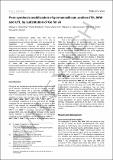Post-synthesis stabilization of germanosilicate zeolites ITH, IWW, and UTL by substitution of Ge for Al
Abstract
Germanosilicate zeolites often suffer from low hydrothermal stability due to the high content of Ge. Herein, we investigated the post-synthesis introduction of Al accompanied by stabilization of selected germanosilicates by degermanation/alumination treatments. The influence of chemical composition and topology of parent germanosilicate zeolites (ITH, IWW, and UTL) on the post-synthesis incorporation of Al was studied. Alumination of ITH (Si/Ge=2–13) and IWW (Si/Ge=3–7) zeolites resulted in the partial substitution of Ge for Al (up to 80 %), which was enhanced with a decrease of Ge content in the parent zeolite. In contrast, in extra-large pore zeolite UTL (Si/Ge=4–6) the hydrolysis of the interlayer Ge−O bonds dominated over substitution. The stabilization of zeolite UTL was achieved using a novel two-step degermanation/alumination procedure by the partial post-synthesis substitution of Ge for Si followed by alumination. This new method of stabilization and incorporation of strong acid sites may extend the utilization of germanosilicate zeolites, which has been until now been limited.
Citation
Shamzhy , M V , Eliašová , P , Vitvarová , D , Opanasenko , M V , Firth , D S & Morris , R E 2016 , ' Post-synthesis stabilization of germanosilicate zeolites ITH, IWW, and UTL by substitution of Ge for Al ' , Chemistry - A European Journal , vol. 22 , no. 48 , pp. 17377-17386 . https://doi.org/10.1002/chem.201603434
Publication
Chemistry - A European Journal
Status
Peer reviewed
ISSN
1521-3765Type
Journal article
Description
M.S. thanks the Czech Science Foundation for the support of the Project 14-30898P. R.E.M. thanks the EPSRC for funding through grant EP/K025112/1.Collections
Items in the St Andrews Research Repository are protected by copyright, with all rights reserved, unless otherwise indicated.

